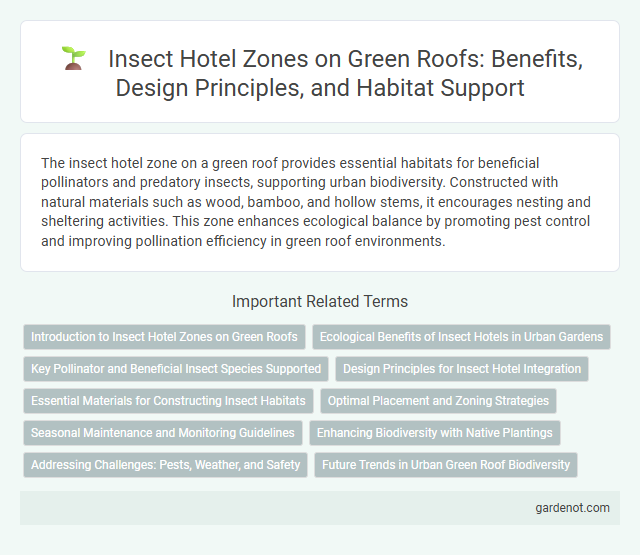The insect hotel zone on a green roof provides essential habitats for beneficial pollinators and predatory insects, supporting urban biodiversity. Constructed with natural materials such as wood, bamboo, and hollow stems, it encourages nesting and sheltering activities. This zone enhances ecological balance by promoting pest control and improving pollination efficiency in green roof environments.
Introduction to Insect Hotel Zones on Green Roofs
Insect hotel zones on green roofs provide essential habitats for pollinators and beneficial insects, supporting urban biodiversity and enhancing ecosystem services. These zones consist of carefully designed structures filled with natural materials like wood, bamboo, and straw to attract various insect species such as solitary bees, ladybugs, and lacewings. Incorporating insect hotels within green roofs improves pollination efficiency and pest control, contributing to the overall health and sustainability of urban green spaces.
Ecological Benefits of Insect Hotels in Urban Gardens
Insect hotels in urban gardens enhance biodiversity by providing essential habitats for pollinators and natural pest controllers, promoting ecological balance. These structures support species such as solitary bees, ladybugs, and lacewings, contributing to pollination and reducing the need for chemical pesticides. Integrating insect hotels within green roofs further improves urban ecosystem resilience and encourages sustainable garden management.
Key Pollinator and Beneficial Insect Species Supported
The insect hotel zone on a green roof supports key pollinator species such as native bees, butterflies, and hoverflies, which are essential for urban biodiversity and plant reproduction. Beneficial insects like ladybugs, lacewings, and ground beetles thrive in this habitat, aiding in natural pest control and enhancing ecosystem resilience. Creating diverse nesting materials and microhabitats within the insect hotel promotes species richness and supports sustainable green roof ecosystems.
Design Principles for Insect Hotel Integration
Insect hotel design within green roofs prioritizes diverse habitat features such as varied cavity sizes, natural materials like bamboo and dead wood, and sheltered locations to maximize insect biodiversity. Integration principles emphasize stability, moisture control, and protection from extreme weather to support pollinators and beneficial insects year-round. Strategic placement near flowering plants enhances ecological connectivity and promotes a balanced urban ecosystem.
Essential Materials for Constructing Insect Habitats
Essential materials for constructing insect habitats on green roofs include untreated wood logs, hollow stems, dried grasses, and pine cones, providing natural shelter and breeding grounds. Incorporating a variety of textures and sizes enhances biodiversity by attracting solitary bees, ladybugs, and lacewings. Using biodegradable and chemical-free components ensures a safe environment that supports pollinators and beneficial insects critical for ecosystem health.
Optimal Placement and Zoning Strategies
Optimal placement of insect hotel zones on green roofs maximizes biodiversity by situating them near flowering plants and sheltered areas to protect from harsh weather. Zoning strategies prioritize creating microhabitats with varying sun exposure and moisture levels, enhancing habitat suitability for diverse pollinators and beneficial insects. Strategic spatial organization promotes effective ecological interactions, supporting sustainable urban ecosystems and improving green roof functionality.
Seasonal Maintenance and Monitoring Guidelines
Regular seasonal maintenance of the insect hotel zone on a green roof includes cleaning debris, checking for structural damage, and replacing worn nesting materials to ensure optimal habitat conditions. Monitoring guidelines emphasize inspecting insect activity levels monthly during growing seasons to track species diversity and population health. Proper maintenance and consistent monitoring support beneficial pollinator presence and biodiversity on the green roof ecosystem.
Enhancing Biodiversity with Native Plantings
Integrating an insect hotel zone within green roofs enhances biodiversity by providing native plantings that attract pollinators and beneficial insects. Native flora supports local ecosystems, offering essential habitats and food sources for various insect species. This strategic planting boosts ecological resilience, promotes natural pest control, and improves overall plant health on green roofs.
Addressing Challenges: Pests, Weather, and Safety
Insect hotel zones on green roofs are designed to mitigate challenges such as pests by attracting beneficial insects that naturally control harmful populations, enhancing the ecosystem's balance. These structures are built with weather-resistant materials that endure varying climates, ensuring insect habitats remain stable during extreme conditions. Safety concerns are addressed through secure placement and non-toxic materials, preventing risks to both insects and humans while promoting biodiversity.
Future Trends in Urban Green Roof Biodiversity
Insect hotel zones on green roofs are evolving as vital habitats to support pollinators and predatory insects, enhancing urban biodiversity. Future trends emphasize integrating smart sensor technologies to monitor insect activity and environmental conditions, promoting adaptive ecosystem management. Advances in materials science enable sustainable and durable insect hotels that optimize microhabitats for diverse insect species.
Insect hotel zone Infographic

 gardenot.com
gardenot.com